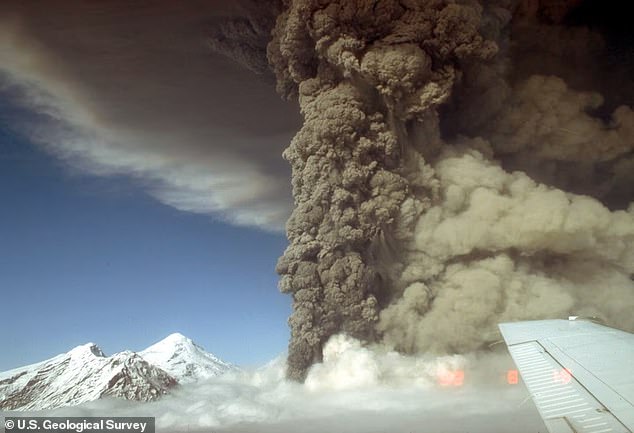Multiple small earthquakes have been detected beneath a massive volcano in Alaska this week, as experts warn it may be ‘moving closer to an eruption.’
Scientists have been keeping a close eye on Mount Spurr, a 11,000-foot-tall volcano that sits just 81 miles from the state’s largest city, over the past few months.
The volcano has been experiencing increased seismic activity, ground-surface displacement and gas emissions, all of which are signs of an impending eruption.
Seismic activity near Mount Spurr kicked off in April 2024, and in October, the rate of quakes increased from an average of 30 per week to 125 per week.
In a Tuesday update, experts at the Alaska Volcano Observatory (AVO) wrote: ‘Unrest continues at Mount Spurr volcano. Seismicity remains elevated with occasional small, shallow volcanic earthquakes detected beneath the volcano over the past day.’
‘AVO continues monitoring activity at Mount Spurr for signals indicating that the volcano is moving closer to an eruption.’
Since the beginning of the month, the US Geological Survey (USGS) has detected hundreds of small tremors within a 30-mile radius of the volcano.
On April 2, a larger magnitude 3.7 quake struck near Petersville at 11:44am, about 30 miles north-west of Mount Spurr. This quake hit 65 miles below the surface – an earthquake depth that would typically be associated with tectonic plate movement.

The last time Mount Spurr erupted was in 1992 (pictured), which scientists said would likely mirror what is expected to occur in the near future
But since Mount Spurr is showing other signs of unrest, it’s possible that this quake was linked to magma rising from deeper in the Earth’s mantle. Scientists estimate an eruption could happen in the next few weeks or months.
In addition to continuous seismic activity, Mount Spurr began releasing elevated levels of gas from its summit crater and a side vent on March 7.
The emissions combined with the earthquakes and ground deformation has put scientists on alert.
The volcano’s summit crater hasn’t erupted for 5,000 years, experts estimate. But its side vent, called Crater Peak, last erupted just 30 years ago.
If Mount Spurr blows again, the eruption will most likely be from this side vent Matt Haney, scientist-in-charge at the AVO previously told DailyMail.com.
The event ‘would be explosive,’ Haney said, explaining that it would spew multiple plumes of ash rising as high as 50,000 feet into the air that may blanked the city of Anchorage in a layer of dust.
Each ash-producing explosive episode would last three to four hours, and the resulting cloud could blanket the city of Anchorage and other nearby communities in a thick layer of dust.
The eruption would also produce destructive mudslides and avalanches of volcanic debris that race down the volcano’s sides at over 200 miles per hour, ‘but fortunately, there are not any communities in that radius that would be affected,’ Haney said.
On March 20, Anchorage officials raised the emergency planning level to Level 2, which means that they will ramp up communication with the public about the threat and public safety agencies will prepare to launch into eruption response protocols.
The last time Mount Spurr erupted was in 1992, and scientists said the imminent explosion would probably be similar to that event.
The volcano covered the entire city of Anchorage in an eighth of an inch of ash during this eruption.
The skies darkened in the middle of the day due to the enormous cloud of dust and gas blotting out the sun, and the city’s airport was forced to shut down for 20 hours.
Crater Peak then erupted two more times, once in August and again in September.
The Municipality of Anchorage reported nearly $2million in damages, office closures and cleanup costs from the August eruption, according to the National Oceanic and Atmospheric Administration.
No one was killed by these events directly. But two heart attacks, one fatal, from shoveling ashfall were reported in Anchorage.
Breathing in ash also poses a health hazards. The tiny particles can work their way deep into the lungs, worsening symptoms for people with respiratory conditions such as asthma or bronchitis.
If Mount Spurr’s activity continues to ramp up, the next sign of an eruption will be a volcanic tremor, Haney warned.









